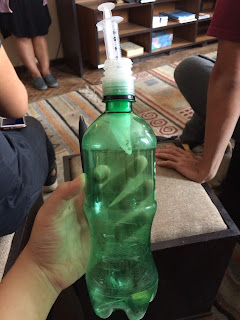During our visit to the Nepal Innovation Lab (NLab), there were a total
of 4 different presentations - the first about NLab and the subsequent 3 about
the projects that they incubated namely Field ready Nepal, Field Site, and
Sikka.
First presentation (About NLab): The Nepal Innovation Lab was
established in 2015 as part of World Vision International Nepal’s Earthquake
Response with the aim to contribute to the national recovery and to inspire the
humanitarian as well as the development sectors to deliver more effective,
high-quality and community-driven responses. It aims to answer 3 questions in
its work: 1. Who can we innovate with/for? 2. How can we integrate the
innovation capacity of Nepal’s private sector into the community? 3. How do we
use innovation to build back communities after catastrophes? As an incubation
Lab, Nepal Innovation Lab provides humanitarian projects with start-up
capital and aids them during their prototyping and developing phase. Following
which, the Lab will offer mentorship, connections to relevant stakeholders, as
well as resources to scale up.
2nd presentation (Field Ready Nepal):
- Uses
3D printers to make items readily available at disaster sites (some
examples for items include medical equipment like scalpel and otoscope.
They also innovate to create new products such as water drainage tools).
- Train
local people, provide them with materials and tools to produce items using
3D printer
- Created
polyfloss, an insulating material for temporary housing structures made
from shredded PET bottles.
- Came
up with house reconstruction model (i forgot the details for this lol)
Their framework: field deployment (manufacture at site) → distributed
manufacturing, sharing information, connecting people → raise awareness of new
technology, train relief workers
3rd presentation (Field site):
- Aim:
to help humanitarian projects to overcome lack of data + lack of
visibility of data + difficulty of monitoring projects
- Consist
of 2 parts: mobile app (collect information) and web app (analyze data -
internal and public dashboards, reports and allows data to be exported)
4th presentation (Sikka):
- A
digital asset transfer platform designed for financially marginalized
people in rural populations
- Problems
Sikka tries to address: logistics, security, high overhead costs,
transparency
- Models:
cash transfer programme model, remittance model, financial service
provider model, know your customer model, cooperative model
When we initially visited the Nepal Innovation Lab, a
majority of us did not expect that the projects implemented by this
organisation would be heavily focused on data and statistics. This came as a
surprise because we thought the organisations would focus on solving more
immediate problems through the implementation of basic strategies, given that
Nepal is an underdeveloped country where the average Nepalese would have little
knowledge of data analysis and usage of technology. Therefore, we felt that the
founders of World Innovation Lab were forward looking in their approach to
tackle issues faced by Nepal, while bearing in mind the needs of their target
audience. What started out as a solution to address the problems posed by the
earthquake in Nepal was posited to address other dilemmas and challenges in
other facets of Nepal’s development. This reminds us that we should always
remain open minded and be adaptable to different scenarios, as one idea may be
a solution to multiple problems.
Written by Joel Chew and Grace Pang







0 comments :
Post a Comment